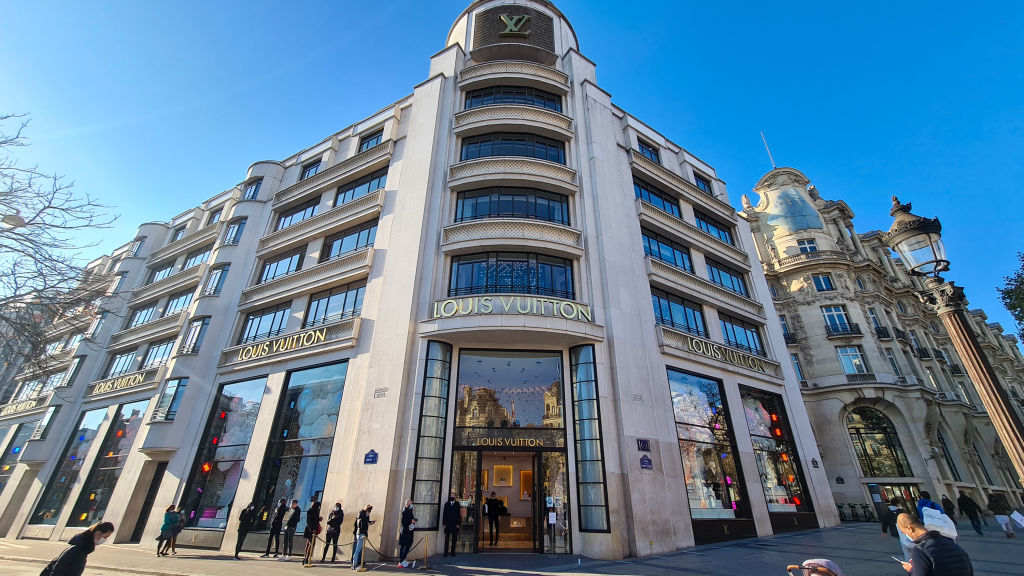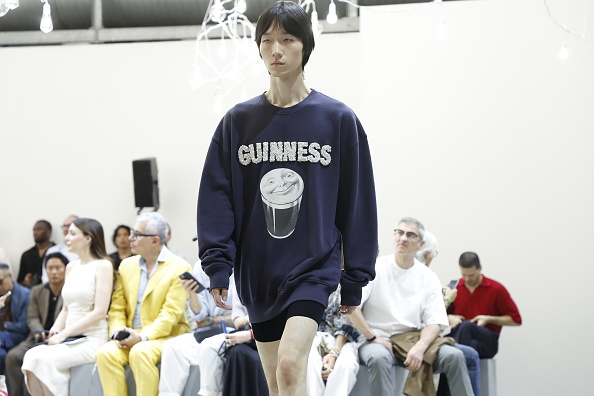Louis Vuitton, Dior Power LVMH’s Sales
Big fashion brands bolster results, while Champagne revenue falls amid pandemic.
PARIS—LVMH Moët Hennessy Louis Vuitton SE said surging revenue at its biggest fashion brands, Louis Vuitton and Dior, propped up the luxury-goods company’s results during the fourth quarter, offsetting other businesses such as Champagne that have fizzled during the pandemic.
The Paris-based conglomerate on Tuesday said revenue in the quarter fell 3% to €14.3 billion ($22.4 billion). Sales at its fashion and leather-goods division—where Louis Vuitton and Dior account for most of the revenue—rose 18%. Revenue for all of 2020 fell 17% to €44.7 billion. Net profit for the entire year was down 34% at €4.7 billion.
The results show how some of the marquee brands of luxury fashion have gained market share during the pandemic. Louis Vuitton, the world’s top-selling luxury brand, Dior and Hermès have posted strong sales growth since boutiques were allowed to reopen after lockdowns in March and April. Smaller brands—both inside and outside LVMH—have lagged behind.
Drawn by the performance of Dior and Louis Vuitton, investors have sent LVMH’s shares to near record highs, brushing aside concerns about the future of the luxury business during and after the pandemic. The company’s market capitalization is now €260 billion, solidifying the place of Bernard Arnault, LVMH’s chief executive and controlling shareholder, among the ranks of the world’s wealthiest people.
Jean Jacques Guiony, LVMH’s chief financial officer, said Louis Vuitton and Dior had a strong pipeline of new products that they continued to roll out despite the lockdowns. The brands also maintained fashion shows in reduced formats and continued digital-marketing efforts when others were forced to pull back drastically. Dior, for example, held a closed-door fashion show for its cruise collection in Lecce, Italy, in July, while rival brands pushed the unveiling of new collections until later in the year.
“We did it when nobody else was talking,” Mr Guiony said. “It was really Dior and Vuitton taking the bulk of the customers’ attention.”
Mr. Guiony said that Fendi and Celine—two of LVMH’s midsize fashion brands—also gathered momentum toward the end of the year. Marc Jacobs managed to turn a profit in 2020 for the first time in years, Mr Guiony said, though that came after a wave of layoffs at the American brand.
LVMH’s performance also benefited from strong consumption of Hennessy, the world’s top-selling cognac brand. Sales in the U.S. surged, LVMH said, bolstered by large government stimulus payments to consumers. Global cognac volumes were down only 4% for the year and rebounded in the second half, the company said.
That helped offset the poor performance of LVMH’s Champagne division, which includes brands such as Veuve Clicquot and Dom Pérignon. With weddings and birthday parties cancelled because of social-distancing rules, consumers had little reason to sip a glass of bubbly, pushing down Champagne sales by 19% for the year.
LVMH just completed its purchase of the American jeweller Tiffany & Co. at the start of this year, after the pandemic nearly cancelled the $15.8 billion deal. Mr Arnault pulled the plug on the merger in September before deciding to see it through after Tiffany agreed to a small discount.
The acquisition could be riding a tailwind: Jewellery sales in the final months of last year were one of the bright spots in the global luxury business, Mr Guiony said.
 Copyright 2020, Dow Jones & Company, Inc. All Rights Reserved Worldwide. LEARN MORE
Copyright 2020, Dow Jones & Company, Inc. All Rights Reserved Worldwide. LEARN MORE
This stylish family home combines a classic palette and finishes with a flexible floorplan
Just 55 minutes from Sydney, make this your creative getaway located in the majestic Hawkesbury region.
As Paris makes its final preparations for the Olympic games, its residents are busy with their own—packing their suitcases, confirming their reservations, and getting out of town.
Worried about the hordes of crowds and overall chaos the Olympics could bring, Parisians are fleeing the city in droves and inundating resort cities around the country. Hotels and holiday rentals in some of France’s most popular vacation destinations—from the French Riviera in the south to the beaches of Normandy in the north—say they are expecting massive crowds this year in advance of the Olympics. The games will run from July 26-Aug. 1.
“It’s already a major holiday season for us, and beyond that, we have the Olympics,” says Stéphane Personeni, general manager of the Lily of the Valley hotel in Saint Tropez. “People began booking early this year.”
Personeni’s hotel typically has no issues filling its rooms each summer—by May of each year, the luxury hotel typically finds itself completely booked out for the months of July and August. But this year, the 53-room hotel began filling up for summer reservations in February.
“We told our regular guests that everything—hotels, apartments, villas—are going to be hard to find this summer,” Personeni says. His neighbours around Saint Tropez say they’re similarly booked up.
As of March, the online marketplace Gens de Confiance (“Trusted People”), saw a 50% increase in reservations from Parisians seeking vacation rentals outside the capital during the Olympics.
Already, August is a popular vacation time for the French. With a minimum of five weeks of vacation mandated by law, many decide to take the entire month off, renting out villas in beachside destinations for longer periods.
But beyond the typical August travel, the Olympics are having a real impact, says Bertille Marchal, a spokesperson for Gens de Confiance.
“We’ve seen nearly three times more reservations for the dates of the Olympics than the following two weeks,” Marchal says. “The increase is definitely linked to the Olympic Games.”

Getty Images
According to the site, the most sought-out vacation destinations are Morbihan and Loire-Atlantique, a seaside region in the northwest; le Var, a coastal area within the southeast of France along the Côte d’Azur; and the island of Corsica in the Mediterranean.
Meanwhile, the Olympics haven’t necessarily been a boon to foreign tourism in the country. Many tourists who might have otherwise come to France are avoiding it this year in favour of other European capitals. In Paris, demand for stays at high-end hotels has collapsed, with bookings down 50% in July compared to last year, according to UMIH Prestige, which represents hotels charging at least €800 ($865) a night for rooms.
Earlier this year, high-end restaurants and concierges said the Olympics might even be an opportunity to score a hard-get-seat at the city’s fine dining.
In the Occitanie region in southwest France, the overall number of reservations this summer hasn’t changed much from last year, says Vincent Gare, president of the regional tourism committee there.
“But looking further at the numbers, we do see an increase in the clientele coming from the Paris region,” Gare told Le Figaro, noting that the increase in reservations has fallen directly on the dates of the Olympic games.
Michel Barré, a retiree living in Paris’s Le Marais neighbourhood, is one of those opting for the beach rather than the opening ceremony. In January, he booked a stay in Normandy for two weeks.
“Even though it’s a major European capital, Paris is still a small city—it’s a massive effort to host all of these events,” Barré says. “The Olympics are going to be a mess.”
More than anything, he just wants some calm after an event-filled summer in Paris, which just before the Olympics experienced the drama of a snap election called by Macron.
“It’s been a hectic summer here,” he says.

AFP via Getty Images
Parisians—Barré included—feel that the city, by over-catering to its tourists, is driving out many residents.
Parts of the Seine—usually one of the most popular summertime hangout spots —have been closed off for weeks as the city installs bleachers and Olympics signage. In certain neighbourhoods, residents will need to scan a QR code with police to access their own apartments. And from the Olympics to Sept. 8, Paris is nearly doubling the price of transit tickets from €2.15 to €4 per ride.
The city’s clear willingness to capitalise on its tourists has motivated some residents to do the same. In March, the number of active Airbnb listings in Paris reached an all-time high as hosts rushed to list their apartments. Listings grew 40% from the same time last year, according to the company.
With their regular clients taking off, Parisian restaurants and merchants are complaining that business is down.
“Are there any Parisians left in Paris?” Alaine Fontaine, president of the restaurant industry association, told the radio station Franceinfo on Sunday. “For the last three weeks, there haven’t been any here.”
Still, for all the talk of those leaving, there are plenty who have decided to stick around.
Jay Swanson, an American expat and YouTuber, can’t imagine leaving during the Olympics—he secured his tickets to see ping pong and volleyball last year. He’s also less concerned about the crowds and road closures than others, having just put together a series of videos explaining how to navigate Paris during the games.
“It’s been 100 years since the Games came to Paris; when else will we get a chance to host the world like this?” Swanson says. “So many Parisians are leaving and tourism is down, so not only will it be quiet but the only people left will be here for a party.”
This stylish family home combines a classic palette and finishes with a flexible floorplan
Just 55 minutes from Sydney, make this your creative getaway located in the majestic Hawkesbury region.






















